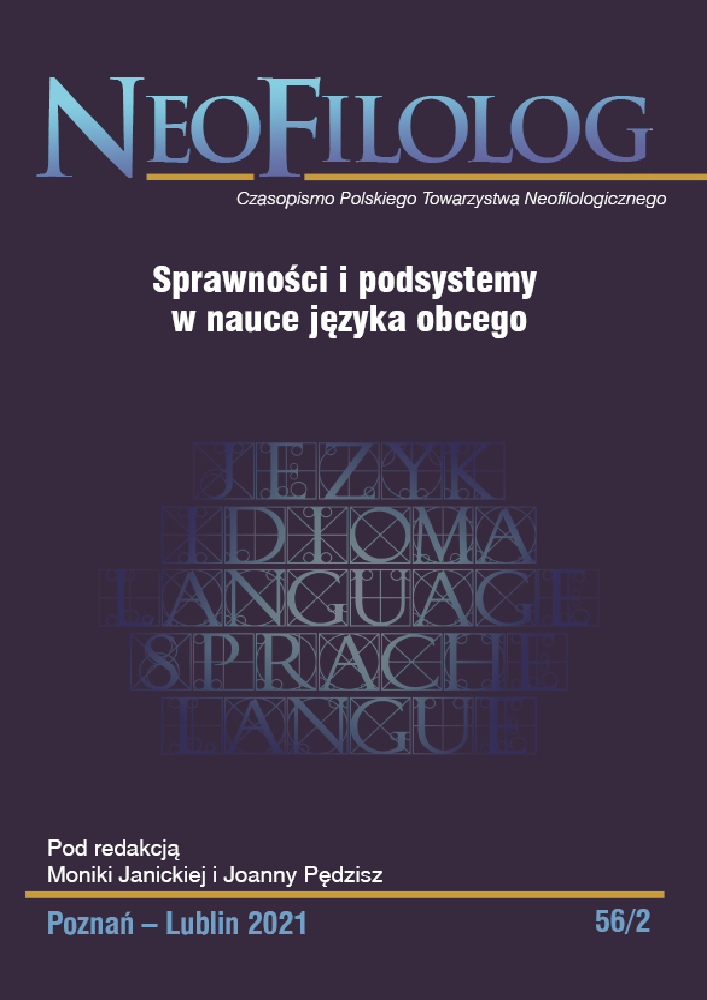Abstract
Sentence adverbials build a multidimensional constituent in many languages, i.e. they can, among others, modify the meaning of the entire sentence, emphasize a particular element in it, or build the coherence in texts. Due to the multifaced character of this linguistic phenomenon the acquisition of it in foreign language learners can be a complex process. The learner is not only faced with a variety of different words and phrases that can be used in order to deliver a complementary information in the text, but also, depending on the structural requirements of the specific language, has to learn to put this constituent in the correct place in the sentence. In present paper the use of sentence adverbials in Polish learners od Swedish will be presented. The data considered in the analysis comprises two types of texts: a summary of an expository text and a narrative. The results show that foreign language learners at the intermediate stage of the language use a broad repertoire of sentence adverbials and place them in appropriate contexts. In narratives modal expressions predominate, while in summaries connectives and intensifiers are used more often. The learners can place sentence adverbials correctly in the sentence, especially in main clauses. However, the word order in dependent clauses when other sentence adverbials occur, except for sentences with the negation inte, is still under development.
Literaturhinweise
Åström, M. (2006), Språkporten - för svenska som andraspråk A och B. Lund: Studentlitteratur.
Biber D. i in. (1999), Longman Grammar of Spoken and Written English. Harlow: Longman.
Bolander M. (1988), „Nu jag hoppas inte så mycke”. Om inversion och placering av negation och adverb i svenska som andraspråk, (w:) Hyltenstam K., Lindberg I. (red.), Första symposiet om svenska som andraspråk. Stockholm: Centrum för tvåspråkighetsforskning, s. 203−214.
Bolander M. (2005), Funktionell svensk grammatik. Stockholm: Liber.
Coste D. i in. (2003), Europejski system opisu kształcenia językowego : uczenie się, nauczanie, ocenianie. Warszawa: CODN.
Grochowski M. i in. (2014), Słownik gniazdowy partykuł polskich. Kraków: Polska Akademia Umiejętności.
Hartmann R., Stork F.C. (1976), Dictionary of language and linguistics. London: Applied Science Publ.
Holm B., Nylund E. (1993), Deskriptiv svensk grammatik. Stockholm: Liber.
Hyltenstam K. (1978), Variation in interlanguage syntax. Lund: Department of Linguistics.
Kowal I. (2020), Satsadverbial i svenskundervisningen — en läroboksanalys. „Scandinavian Philology”, nr 18(1), s. 56−71.
Laskowski R. (1999), Zagadnienia ogólne morfologii, (w:) Grzegorczykowa R., Laskowski R., Wróbel H. (red.), Gramatyka współczesnego języka polskiego. Morfologia. Warszawa: Wydawnictwo Naukowe PWN, s. 27−50.
Levy Scherrer P., Lindemalm K. (2008), Rivstart B1 + B2. Textbok. Stockholm: Natur och kultur.
Lindholm H. (1997), Svensk grammatik. Svenska som främmande språk. Lund: Kursverksamhetens förlag.
Lindström E., Lubinska D. (2019), En deskriptiv longitudinell studie av konnektorbruk i nybörjarsvenska hos vuxna inlärare, (w:) Ljung Egeland B. i in. (red.), Klassrumsforskning och språk(ande). Classroom research and language/lan-guaging. Rapport från ASLA-symposiet i Karlstad, 12–13 april, 2018. Papers from the ASLA symposium in Karlstad, 12–13 April, 2018. Karlstad: Karlstads universitet, s. 61−87.
Mirowicz A. (1948), O partykułach, ich zakresie i funkcji. „Biuletyn PTJ”, nr 8, s. 134−148.
Pienemann M., Håkansson G. (1999), A Unified Approach toward the Development of Swedish as L2. A Processability Account. „Studies in Second Language Acquisition”, nr 21(3), s. 383−420.
Saloni Z. (1974), Klasyfikacja gramatyczna leksemów polskich. „Język polski”, nr 14(2), s. 93−101.
Strutyński J. (2002), Gramatyka polska: wprowadzenie, fonetyka, fonologia, morfologia, składnia (wyd. 5). Kraków: Wydawnictwo Tomasz Strutyński.
Swan M. (2005), Practical English usage. Oxford: Oxford University Press.
Szober S. (1923), Gramatyka języka polskiego. Lwów-Warszawa: Książnica Polska.
Świątkowska M. (2014), O partykułach inaczej. Kilka uwag o problemach terminologicznych, (w:) Bednarczuk L. i in. (red.), Linguistique romane et linguistique indo-européenne : mélanges offerts à Witold Mańczak à l’occasion de son 90e anniversaire. Kraków: Uniwersytet Jagielloński. Instytut Filologii Romańskiej, s. 445−450.
Teleman U. i in. (1999), Svenska Akademiens grammatik. 4, Satser och meningar. Stockholm: Norstedts Ordbok.
Thomson A.J., Martinet A.V. (2001), A practical English grammar. Oxford: Oxford University Press.
Vaakanainen V. (2018), Konnektorbrukets utveckling i finska inlärares L2-svenska, (w:) Sköldberg E. i in. (red.), Svenskans beskrivning 35: Förhandlingar vid trettiofemte sammankomsten Göteborg 11–13 maj 2016. Göteborg: Göteborgs Universitet, s. 341−353.
Wajszczuk J. (2005), O metatekście. Warszawa: Katedra Lingwistyki Formalnej UW.
Lizenz
Copyright (c) 2021 Iwona Kowal

Dieses Werk steht unter der Lizenz Creative Commons Namensnennung - Keine Bearbeitungen 4.0 International.
Autoren:
Die Autoren der zur Veröffentlichung in der Zeitschrift Neofilolog angenommenen Texte sind verpflichtet, den Vertrag über die Erteilung einer kostenlosen Lizenz für die Werke mit der Verpflichtung zur Erteilung einer Sublizenz CC auszufüllen, zu unterzeichnen und an die Adresse der Redaktion zurückzusenden.
Gemäß Vertrag erteilen die Autoren auf die in der Zeitschrift Neofilolog veröffentlichten Texte der Adam-Mickiewicz-Universität in Poznań eine nicht exklusive und kostenlose Lizenz und erlauben die Verwendung der Sublizenz Creative Commons Attribution-NoDerivatives 4.0 International (CC BY-ND 4.0).
Die Autoren behalten das Recht zur weiteren freien Verfügung über das Werk.
Benutzer:
Interessierte Onlinebenutzer dürfen die seit 2017 veröffentlichten Werke unter folgenden Bedingungen nutzen:
- Anerkennung der Urheberschaft - die Verpflichtung, zusammen mit dem verbreiteten Werk Informationen über die Urheberschaft, den Titel, die Quelle (Links zum Originalwerk, DOI) und die Lizenz selbst bereitzustellen;
- ohne Schaffung abgeleiteter Werke - das Werk muss in seiner ursprünglichen Form erhalten bleiben, ohne Zustimmung des Autors dürfen keine Studien, beispielsweise Übersetzungen, verbreitet werden.
Die Urheberrechte aller veröffentlichen Texte sind vorbehalten.
Sonstige:
Die Adam-Mickiewicz-Universität in Poznań behält das Recht auf die Zeitschrift als Gesamtheit (Layout, Grafik, Titel, Umschlagsprojekt, Logo usw.).

